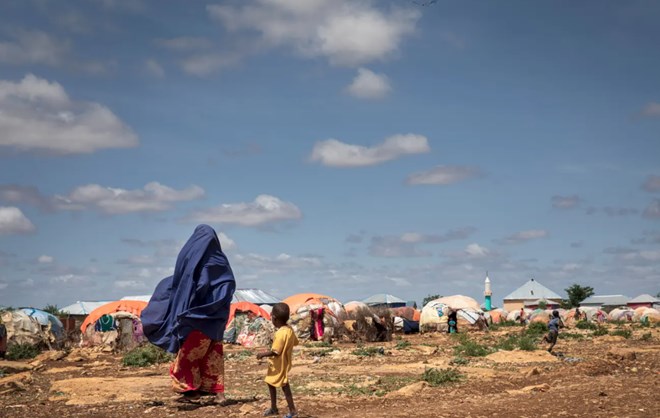
by Fathi Mohamed Ahmed in Baidoa
Global development is supported by
Bill and Melinda Gates Foundation
Friday June 24, 2022

A camp for internally displaced people near Baidoa, Somalia
First the crops failed. Repeated droughts meant the Keer family could no longer grow the fruit and vegetables that once provided them with an income. Then their animals died. The herd of 40 goats dwindled to six. None of their cows survived. When the river ran dry, leaving them without water, the family agreed they had no choice but to leave their home in the village of Bootis, south-west Somalia.
The 65km journey to Bulo Garas camp, east of Baidoa in South West state’s Bay region, took four days. On the way, one of the donkeys pulling the family’s cart died. They hoped the camp would offer some relief from their situation.
Earlier this year, the UN described Somalia as “staring at a potential catastrophe” after three consecutive failed rainy seasons. Now that a fourth rainy season has failed, the drought has worsened. This week the UN warned that only a massive and immediate injection of funding would avert famine in Somalia. Claire Sanford, deputy humanitarian director of Save the Children, said the crisis was the worst she has seen in her 23-year career.Yet life at Bulo Garas camp, home to 630 families, is little different to the way it was in the village. The camp, which opened last month, has no water point – residents rely on people in Baidoa to give or sell them water – and food is scarce. New arrivals have to construct dwellings out of whatever they can find.
As the eldest of the five children, Khadijo Abdi Keer, 20, feels responsible for looking after the family, but her disability makes it impossible for her to fetch food and water.
“As the first-born child there is a lot of expectation on me to help the rest of my family,” says Keer, sitting in front of the small structure made from old clothes and twigs she now calls home, exhausted from the journey. “I am the one who is supposed to fetch water and find food, but as I cannot move or see I have to depend on others.
“Last night we had nothing to eat,” she says. “We only have one meal a day of beans and tea.”
Keer says her father was too frail to travel with them and her mother “lacks the skills to earn a living in town”.
“We have not yet found a proper place to live or a regular supply of food,” adds Keer.
In 2011, the first famine of the 21st century was declared in Somalia. Nearly 260,000 people died, half of them children. But this drought is different, according to Abdinasir Abdi Aruush, South West state’s minister of humanitarian affairs and disaster management.
“In 2011, the world was conscious of the situation here, which resulted in a swift humanitarian response which saved many lives,” he says. “This time around, nobody is interested because they are focusing on the war in Ukraine. People must stand up in solidarity with the starving in Somalia and other parts of the Horn of Africa. Our government must also come up with plans to prevent future disasters.”
South West state has been hard hit by the drought. Once known as the breadbasket of Somalia, with a history of sorghum cultivation, the erosion of agriculture and political instability in the region have worsened the effects of climate crisis with devastating results.
Many of those worst affected by the drought are children. About 120 malnourished children are now being treated at a care centre for the under-fives in Baidoa, run by Save the Children.
Aniso Mohamed’s two-year-old daughter is one of those receiving help. Her body is swollen, and she suffers from diarrhoea and vomiting. She is being given medicine, milk and biscuits.
But staying by her sick daughter’s side means Mohamed, 28, cannot care for her other five children.
“I was a farmer until the drought forced us to flee to Baidoa,” she says. “Since arriving here I have been managing to put food on the table by working as a porter shuttling produce from shops and homes. But I had to put that on hold because I now spend every day in the centre. Their father does not work.”
Life is improving slowly for Idaja Hussein Hassan, a 40-year-old mother of five. She arrived in Baidoa three months ago after crops failed. When her 18-month-old son, Hussein Hilowle Mohamed, fell ill, she took him to Bardaale maternity and child welfare centre in the city, also run by Save the Children.
A Somali man disposes of his dead livestock in a country that has seen its worst drought in 40 years
Somalia: ‘The worst humanitarian crisis we’ve ever seen’
The centre has treated 396 malnourished children since the beginning of June. Sixty pregnant women, also suffering from malnutrition, have been admitted to the centre.
“Our four midwives are working 24/7,” says Hafso Moalim, who runs the centre. “Sometimes we run out of supplies which means we cannot properly care for the vulnerable mothers and children.”
The situation is only going to get worse. The UN says more than 18 million people are suffering from acute food insecurity across the Horn of Africa, seven million of them in Somalia, almost half the population. Every day there are more arrivals at Bulo Garas, as people like the Keers, at the centre of the crisis engulfing the country, abandon their homes in order to survive.
Fathi Mohamed Ahmed is deputy chief editor of Bilan, Somalia’s first all-women media house